Province IX bishops study self-sustainability in the PhilippinesPosted Oct 8, 2014 |
|
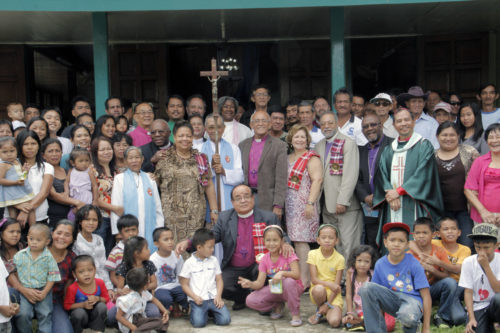
Bishops from Province IX spent Sept. 24-28 in the Philippines studying the church’s journey to financial self-sustainability in the local context. Photo: Lynette Wilson/ENS
[Episcopal News Service – Manila, Philippines] In sewing workshops, homes and sheds on either side of the road reaching to the top of a hill where Holy Faith Episcopal Church sits in Igorot Village, men weave hats, scarves and sweaters and women sew labels on finished goods. It’s a cottage industry started by six women who sell knitwear to wholesalers; it keeps the village humming.
The village was founded in the 1950s on 1.5 hectares of land that was once part of a cattle ranch by Igorots, or “mountain people,” from Luzon, the largest, northernmost island province of the Philippines where Anglican missionaries established a presence in the late 19th century. Located on the outskirts of Manila, the village of former bamboo and grass huts, now is home to more than 100 families living in concrete homes with metal roofs.
As the community developed, a preaching station became a mission congregation, an aided parish, and in 2010 called a full-time rector.
Yet in 2013, at a time when the parish already was 80 percent self-supporting, the congregation felt it couldn’t reach the goal of 100 percent by 2018. That’s where the Episcopal Church of the Philippines’ unique approach to Asset-based Community Development, an approach that includes congregational development, applied. In taking stock of the village’s assets leaders determined that wholesalers were selling on three months’ consignment meanwhile taking out private loans to maintain operations; and the church stepped in to address a need.
With an $11,000 loan from 22 communities in the Diocese of the Southern Philippines, Holy Faith began making loans to the wholesalers at 1.5 percent interest, less than half the 3 to 5 percentage rate charged by private lenders. In a win-win, the wholesalers invested a percentage of the savings into the church In February 2014, Holy Faith members requested full-fledged parish status.
Holy Faith is just one example in the Episcopal Church of the Philippines where community and congregational development have gone hand-in-hand, creating a situation where both thrive.
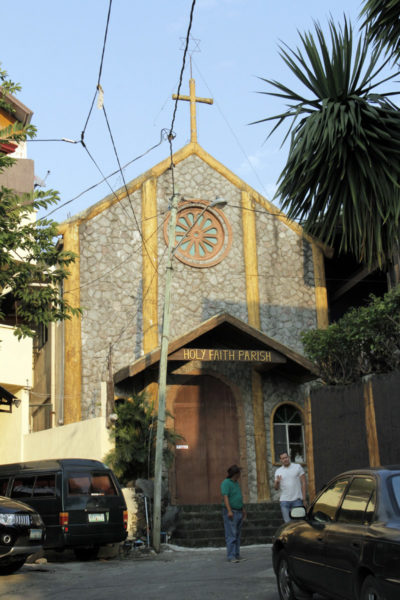
Holy Faith’s stone stonework is modeled after that in the north’s mountain province, where the Igorot people are from. Photo: Lynette Wilson/ENS
When the church first began thinking about autonomy and financial self-sustainability it invested in programs and projects to raise money, but in the end, without the community development component, the investments were a “complete failure,” said Floyd Lalwet, the church’s provincial secretary, during a Sept. 24 gathering at the church’s national office in Quezon City. Over time the church began to see the communities and the congregations as one, things began to change.
The Episcopal Church in the Philippines’ journey toward financial self-sustainability serves as an example of covenant partnership, one that can be replicated in other contexts.
Earlier that day on Sept. 24 seven bishops and two spouses representing Province IX traveled to the Philippines with the purpose of affirming and strengthening the companionship between the Episcopal Church in the Philippines and the U.S.-based Episcopal Church, and to experience the work of the local church as related to its attainment of full-financial autonomy and, more specifically, the implementation of its Asset-Based Congregational/Community Development program and the application of its “from receivers to givers” policy.
Prior to traveling to the Philippines to study the church’s journey to financial self-sustainability in the local context, the bishops and spouses spent Sept. 17-23 in Taiwan attending the fall House of Bishops. meeting, where Prime Bishop Edward P. Malecdan spoke about the theological context and mission challenges in the Philippines.
Staying true to the House of Bishops’ meeting’s theme of “expanding the apostolic imagination,” bishops explored the mission and ministry of the Diocese of Taiwan; following the meeting other bishops and spouses traveled in groups to Japan, Hong Kong and South Korea to continue learning about mission and ministry of the Anglican Church.
The Province IX bishops visit to the Philippines was three years in the making.
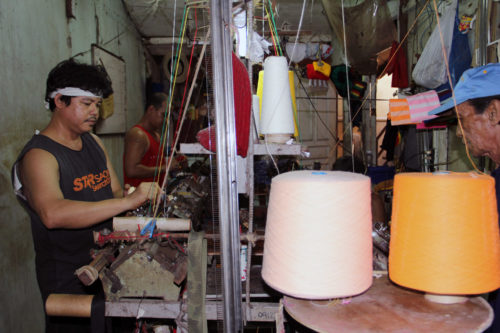
Men weave hats, scarves and sweaters in workshops like these in Igorot Village. Photo: Lynette Wilson/ENS
Clergy and lay leadership in the Episcopal Church’s seven Latin American dioceses, covering the Caribbean, Central and South America, first became acquainted with Episcopal Church of the Philippines’ story during a 2011 conference on self-sustainability in Tela, Honduras.
The Province IX dioceses – the Dominican Republic, Honduras, Central Ecuador, Ecuador Litoral, Colombia, Venezuela and Puerto Rico – adopted self-sustainability as a focus in a 2012 synod meeting.
Each of the Province IX dioceses are on their own path to financial self-sustainability, with the Dominican Republic, Honduras and Central Ecuador, with a recent $4 million land sale, closer than the others.
The comprehensive approach to financial sustainability in Province IX is driven by the needs of each individual diocese, and the approach has come from the diocese’s themselves, said Samuel McDonald, the Episcopal Church’s deputy chief operating officer and director of mission.
“Here’s where the rubber meets the road,” he said.
Executive Council in February 2014 adopted the Second Mark of Mission Province IX Sustainability Plan, which was the result of a July 2013 meeting of lay and ordained leaders of the province and church center staff.
Following the Tela conference, said Lalwet, the Province IX bishops began asking for specifics regarding the Philippines’ church’s capacity building projects and processes, specifically how cooperatives have aided congregations in becoming full-fledged parishes and the Episcopal Development Foundation of St. Mark’s, a lending institution which transformed the Diocese of Santiago in the northern Philippines.
There are some 43 registered cooperatives and about 65 un-registered co-ops, farmers associations and development organizations operating under the church’s church and community development model. The Episcopal Care Foundation, or ECARE as the development model is called, strives through partnerships to work with communities to leverage their assets and resources to move from subsistence to self-reliance, while emphasizing sharing, caring, witness and environmental stewardship.
The cooperative concept was something new to Diocese of Colombia Bishop Francisco Duque, who also serves as the Province IX president; it’s something, he said, he’ll look at implementing in his own diocese, one of the youngest in the Episcopal Church.
In Colombia, as in the Philippines and the other Province IX dioceses, many Episcopal churches are located in poor, marginalized communities in need of economic and social development.
More than 25 percent of the Philippines’ 100 million people live below the poverty line, a percentage similar to Ecuador and Venezuela, though their populations are a fraction of that of the Philippines’, according to World Bank statistics. Each of the other Province IX dioceses has a higher percentage of people, between 33 and 65, living below the poverty line.
“The economic and political reality is that our people live in poverty and that our churches are located in marginalized communities,” Lalwet said, adding that by focusing on improving the economic livelihood of people in the community the people are better able to support the church.
This approach, however, from the outset necessitates church and community consensus, he said. “It would also be an error to separate the community development program from church development.”
It also meant a change in mindset, congregations that historically had been recipients, needed to become the givers. “We were breaking the mindset that the church should support the congregations,” said Lalwet.
Historical background
The Episcopal Church established a missionary district in the Philippines in 1898; in 1965 the church became a missionary diocese and in 1990 the Episcopal Church of the Philippines became an autonomous province of the Anglican Communion. However, autonomy came before financial self-sustainability: in 1990 the Philippines’ church still relied on the U.S.-based Episcopal Church to finance 60 percent of its operating budget.
In 1992, the Joint Committee on the Philippine Covenant proposed a 15-year stepped reduction plan to gradually reduce every five years’ the Episcopal Church’s support from $800,000 to $533,333 to $267,667. In 2003, Philippine Church ran its highest-ever budget deficit of 6.5 million pesos ($120,000 at the time). And in 2004, the church decided to ask the Episcopal Church for a three-year extension before reversing course.
In 14 years of being autonomous all anyone ever talked about was the subsidy, said Lalwet, until finally someone proposed, “Why don’t we do away with it?”
So they did. And on January 1, 2005, “everyone predicted that the 6.5 million peso deficit would double,” he said, but it didn’t. Instead, for the first time ever, the church had a $55,000 budget surplus.
Lalwet often equates the 15-year period of the subsidy’s attenuation as an addict going through withdrawal. “There were times when people didn’t receive a salary for six months,” he said.
The covenant relationship between the U.S.-based Episcopal Church and the Episcopal Church in the Philippines remained intact in 2005, but rather than use the subsidy for operating expenses the money was added to the church’s Centennial Endowment Fund, established in 2001.
To encourage the church’s then-six dioceses to contribute to the fund, the church changed the fund’s structure. Rather than position the endowment fund as a “national fund” with monies going to support the Episcopal Church of the Philippines, the church split the fund between the dioceses, used a grant and rental income to provide matching funds and loaned the money back to the dioceses for local investment, said Lalwet.
Additionally, Lalwet explained, rather than rely on the subsidy for its operating budget, the church looked to its existing assets and institutions for support; during the period from 2005-08, with the support of St. Luke’s Medical Center in Quezon City, some of the province’s most beautiful churches were built.
Today there are more than 120,000 baptized Episcopalians worshipping in 400 churches across the Episcopal Church in the Philippines’ seven dioceses covering the archipelago in the Pacific Ocean
Development cooperatives
In the 1960s and ‘70s when the church first began to consider autonomy it started founding cooperatives, which during the period of martial law from 1972 to 1981 implemented by President Ferdinand Marcos, was dangerous.
“Co-ops were considered subversive,” said Lalwet, adding that the church, specifically in Diocese of Northern Luzon, where Bishop Richard Abellon, who would become the first-ever Filipino prime bishop. “The bishop became public enemy number one.”
Despite the harassment and threats directed at Abellon and others, the church continued to found cooperatives because the leadership believed it was the way forward.
Santiago
A 40-minute flight north from Manila to Tuguegarao and another two to three hours by minibus along a two-lane highway deep in the country’s rice basket, where yellow corn for livestock feed and rice dry along the road’s narrow shoulder and on any unused pavement with access to direct sunlight, the bishops arrived in Santiago, where local investment has defined the Diocese of Santiago’s success.
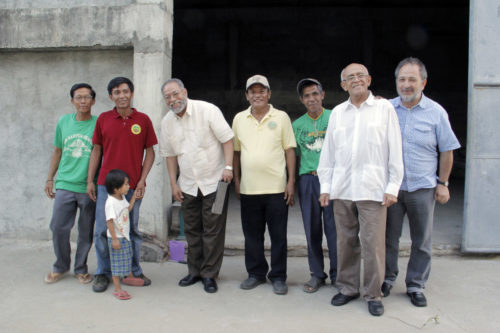
Bishop Julio Cesar Holguin, Bishop Orlando Guerrero and Bishop Luis Ruiz pose with members of St. Peter’s co-op. Photo: Lynette Wilson/ENS
The Diocese of Santiago, formerly a part of the Diocese of North Luzon, was founded in 2001, and at the time received 90 percent of its support from outside the diocese.
“This diocese was formed during the most difficult financial years of our church, when the Episcopal Church support was being reduced; when we were in withdrawal,” said Lalwet. “This diocese suffered because it was very dependent on the Episcopal Church of the Philippines.”
It wasn’t easy, explained Lalwet, as relationships, some of them longtime friendships, were strained as a result of the subsidy’s elimination.
Yet, in the end, the diocese started the Episcopal Development Foundation of St. Mark’s, the lending institution that has accumulated a $1.9 million loan portfolio in 10 years, and among other things has enabled farmers to acquire 30 hectares of land. But it is also the biggest source of support for the Diocese of Santiago, contributing $56,000 a year.
In addition to visiting the diocesan office, where they learned about the Foundation of St. Mark’s and shared a meal with clergy and lay leaders from both the North Luzon and Santiago dioceses, the bishops visited two cooperatives, each in very different stages of development.
The first was Del Pilar in Alicia, where the majority of the community’s 3,000 inhabitants are farmers working from a few to a dozen acres of land, mostly by hand and using water buffalos. The church in 2002 established St. Peter’s Savings and Credit Co-op with 15 members, which has since grown to 39. The co-op allows the farmers to negotiate better prices for seed, to rent a drying pavement (access to space for drying rice and corn is scarce), and has constructed a warehouse where grains can be stored and sold as commodity prices dictate. the co-op also has a nine hectare rice farm.
St. Peter’s was modeled after the second cooperative, Holy Spirit Mission and Multi-Purpose Cooperative, which was begun in 1995 and is further along, explained the Rev. Ralph Dampo, who serves as the parish’s director and manager of the cooperative.
Dampo, who was trained in both theology and business management with support from the church, began the mission with the simultaneous goal of improving the lives and economic livelihoods of the farmers in the community and the life of the mission station.
After first conducting a rural assessment: a survey of the land, number of households, linguistics, access to social and educative services, the cooperative started with 16 subsistence farmers, each of whom contributed one fifth of their annual income, about 1,000 pesos, or $22. “It was hard,” said Dampo.
Today, the co-op has more than 100 members, 10 regular employees, a warehouse, drying pavement, trucks. It contributes 10 percent of its income to the parish’s endowment and other funds, pays 70 percent of Dampo’s salary, while supporting the Holy Spirit’s children’s ministry, and has a feeding program, and a relief and rehabilitation ministry.
The first church building was constructed in 1997 and a modern building in 2009; Holy Spirit has 200 members, half of them members of the co-op, and an average Sunday attendance of 70, said Dampo.
Cotabato
From their base in Quezon City, the bishops then traveled south an hour and a half by airplane to Cotabato City where they met Diocese of the Southern Philippines Bishop Danilo Bustamante, visiting St. Francis Church and the Hillside Multi-Purpose Cooperative in Upi, in the province of Maguindanao in the Autonomous Region of Muslim Mindanao, where at 30 percent of the population Christians are the minority.
The group also met with Upi Mayor Ramon A. Piang at his municipal office, where he told them that the local government supports church leaders, and has instituted civic panels, including religious and other civil society leaders, and coordinates with them on poverty reduction programs in the province where 98 percent of the people are farmers.
Seeing the cooperatives in action in the Philippines made Bishop of Venezuela Orlando Guerrero think about the 35 hectare coffee plantation his diocese owns in the country’s northeast, a plantation that isn’t producing to its full yield. Rather than work the plantation with local labor,Guerrero said, he’s considering forming a cooperative and giving local families parcels to work.
The Venezuelan government, he added, also works with religious organizations to empower communities, but that to date the Episcopal Church, unlike the Evangelical and Roman Catholic churches, has not taken advantage of that opportunity.
The co-ops also got Diocese of Honduras Bishop Lloyd Allen thinking about how his diocese’s existing cooperative might be restructured to provide each of 10 deaneries in Honduras with more local authority.
The Southern Philippines program in Upi, like in the north, includes grain drying and storage facilities, but also a rubber tree plantation and nursery, the latter a partnership with the Diocese of Olympia in Seattle, Washington, that distributes seedlings to individual households.
Build the road as you walk it
“We are here as one church … we are here from Latin America to see with our own eyes,” said the Rev. Glenda McQueen, the Episcopal Church’s global partnership officer for Latin America and the Caribbean, during a sermon she preached at St. Francis Church in Upi, on the morning of Sunday, Sept. 28.
“To change direction is to say yes to life, to leave the past, the way things were done, and take the risk into the future.”
McQueen talked about how the Anglican and Episcopal churches planted the seed that today is the church in the Philippines, and how like the rubber trees, where grafting a branch from a mature tree onto a seedling makes the young tree stronger and more resistant to diseases, the Philippines’ sharing its journey toward financial self-sustainability gives strength to the Latin American churches who are on a similar path.
“We are that new tree, and you have given us the example of that new church that took the risk,” said McQueen, and she explained to those present that there’s a saying in Latin America Se hace el camino al andar or “build the road as you walk it”; it describes the journey the Province IX bishops and their dioceses now are on.
Moving forward with self-sustainability in Province IX, each diocese will need a person or a team to give oversight to the development process, McQueen said later in an interview with ENS.
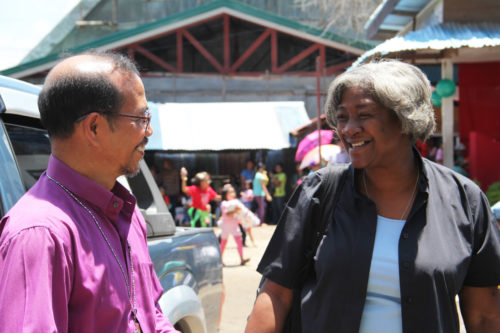
Diocese of the Southern Philippines Bishop Danilo Bustamante and the Rev. Glenda McQueen, the Episcopal Church’s global partnership officer for Latin America and the Caribbean in Cotabato. Photo: Lynette Wilson/ENS
Visiting the church in the Philippines provided the bishops with the principles that hold the process together — “you need to have that foundation,” she said.
It’s important, she added, the Latin American churches articulate their own vision for the future, and that they together look at what they have as a province.
Reflecting on the visit to the Philippines’ church, Dominican Republic Bishop Julio Cesar Holguin said he believed the clergy’s and laity’s entrepreneurial spirit in the face of losing the support of the Episcopal Church and that spirt allowed them to continue in their development.
“I believe that the Philippines’ model can serve as a great help and inspiration for all of the dioceses of Province IX, as in other parts of the Anglican Communion,” said Holguin.
“We are encouraged to throw ourselves into the goal of sustainability, and to carry out with more efficiency, the task of the Great Commission that our Lord Jesus Christ has charged us with.”
— Lynette Wilson is an editor/reporter for the Episcopal News Service.

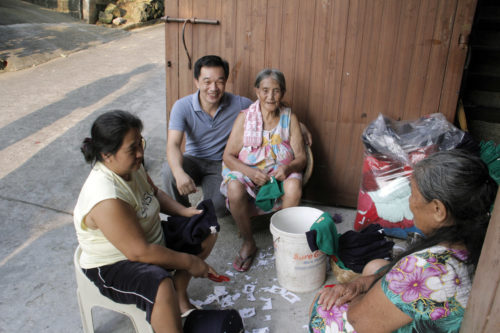
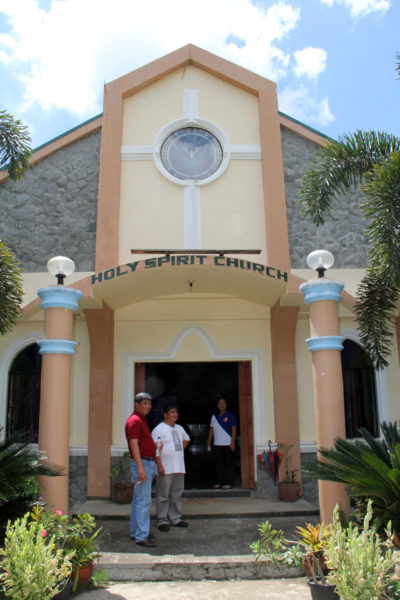
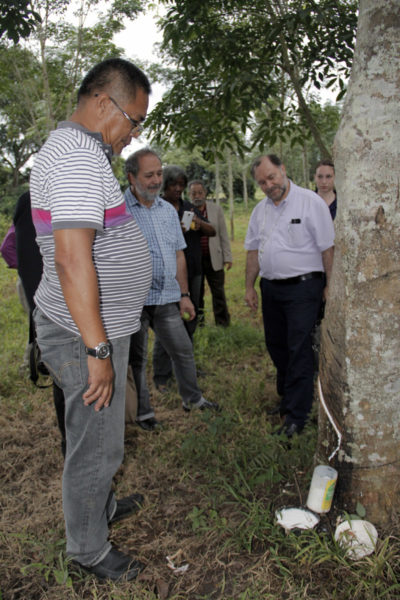
Social Menu